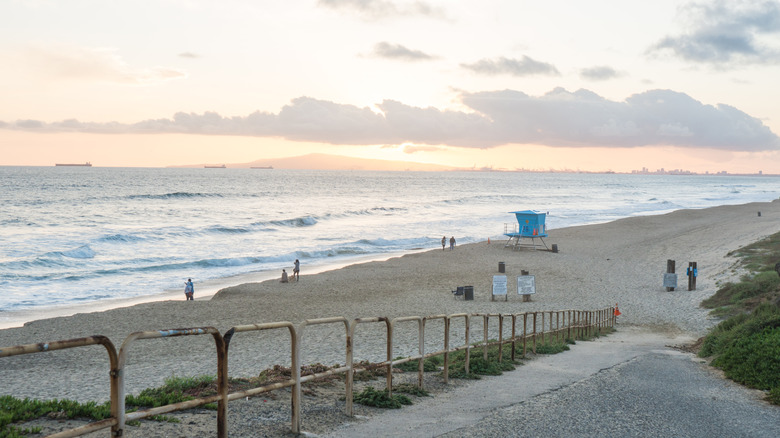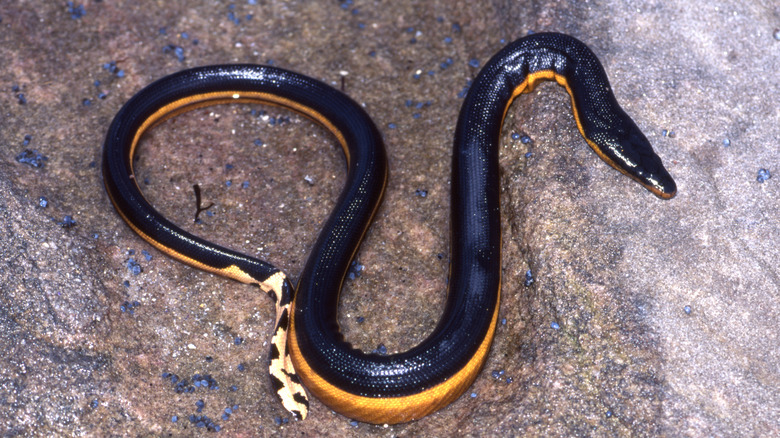Watch Out For This Creature When Visiting The Beaches Of Southern California
When you think of danger at the beach, you might think of aggressive sharks or thieves stealing your bag when you're going for a dip in the ocean. However, there's another danger lurking at some California beaches: yellow-bellied sea snakes.
Officially known as "Pelamis platurus," yellow-bellied sea snakes live in the water and are typically spotted in the Indian and Pacific Oceans. These reptiles are rare but are found most often in tepid, shallow waters — the same ones you might be swimming in during your California vacation. And that's bad news because the yellow-bellied sea snake is extremely venomous, with a bite designed to shock and kill its prey.
Thankfully, the snake's prey tends to be fish, and as Greg Pauly, Assistant Curator of Herpetology at the Natural History Museum of Los Angeles County, told ABC, it's unusual that a yellow-bellied sea snake bite would be strong enough to kill a human. With that said, this still isn't a creature you want to swim alongside, and to keep yourself safe, there are some precautions you should take when heading to Southern California beaches.
Where yellow-bellied sea snakes have been spotted
Given that yellow-bellied sea snakes live in the Pacific Ocean, it's not a complete shock when one washes up in California. Still, their presence in the Golden State is unusual and requires certain conditions. Harvey Lillywhite, a sea snake expert at the University of Florida, explained to National Geographic that the waters around California are often too cold for yellow-bellied sea snakes to thrive in. However, if the ocean temperatures rise or if El Niño is in effect, the serpents may find their way to the California coast just as they did in late 2015 and early 2016.
The first sighting occurred at an Oxnard beach in October 2015. Just two months later, another yellow-bellied sea snake was spotted at Bolsa Chica State Beach, near Huntington Beach. Finally, in January 2016, The Guardian reported a third snake had been discovered at a beach near San Diego.
While rare, the snake hasn't disappeared from California shores since then. In early 2018, the Los Angeles Times revealed that a yellow-bellied sea snake was found alive in the sand in Newport Beach.
How to protect yourself
Given how uncommon it is to find a yellow-bellied sea snake in California, there's no reason to avoid the beach when visiting the state. And even if you do happen upon one, it might not be strong enough to do any damage. "When one of these marine serpents washes up on a beach," Greg Pauly told the Los Angeles Times, "it means it is sick and doesn't have enough energy to swim out beyond the shore break." As a result, the reptiles may not have the strength to attack or defend themselves. In fact, the snake found in 2015 at Bolsa Chica State Beach was already dead when beachgoers discovered it.
Nevertheless, it's always a good idea to know how to keep yourself safe when spending time on the coast. First, note what yellow-bellied sea snakes look like. Just as its name suggests, the ophidian is yellow on its underside, with black on top. It also has distinct markings on its tail — look for a yellow patch with black dots.
If you come across the snake, the best course of action is to remain at a safe distance — the snake might attack if it feels scared or provoked. If it's too late and you've already been bitten, Healthline urges calling for emergency help immediately. Limit your movement to prevent the venom from traveling through your body. When paramedics arrive, you may be given antivenom to block the effects of the snake's toxins.


